Comprehensive Analysis: Health Effects of Air Pollution in Australia
VerifiedAdded on 2023/01/18
|9
|1927
|79
Report
AI Summary
This report investigates the impact of air pollution on public health in Australia, focusing on the adverse effects on the cardio-respiratory system, increased mortality, and hospital readmissions. The research utilized databases like Pubmed, CINAHL, and MEDLINE to gather peer-reviewed journals from 2012 to 2018, examining the relationship between air quality and health outcomes in Australia. The findings reveal that major air pollutants, including particulate matter, carbon monoxide, ozone, and nitrogen oxide, contribute to various health issues such as lung cancer, lower respiratory tract infections, and asthma attacks. The study also highlights the role of vehicle emissions, coal combustion, and dust storms in exacerbating air pollution. The report discusses interventions like public transport, cleaner energy sources, and stricter emission standards to mitigate the problem. The study also discusses the plausible biological mechanisms and gaps in the research with suggestions for future studies. This report provides valuable insights into the health challenges posed by air pollution and potential solutions for improving public health in Australia.
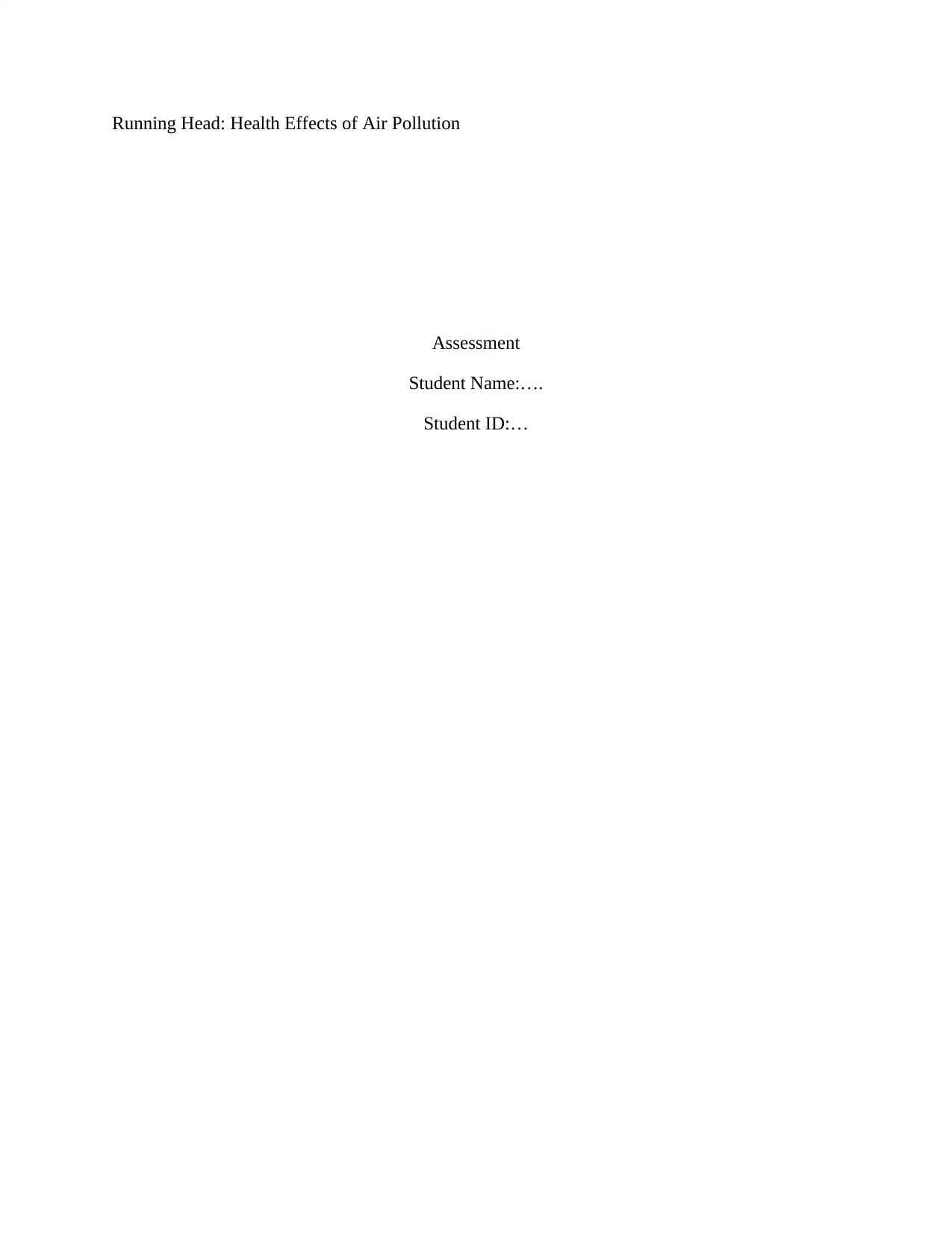
Running Head: Health Effects of Air Pollution
Assessment
Student Name:….
Student ID:…
Assessment
Student Name:….
Student ID:…
Paraphrase This Document
Need a fresh take? Get an instant paraphrase of this document with our AI Paraphraser
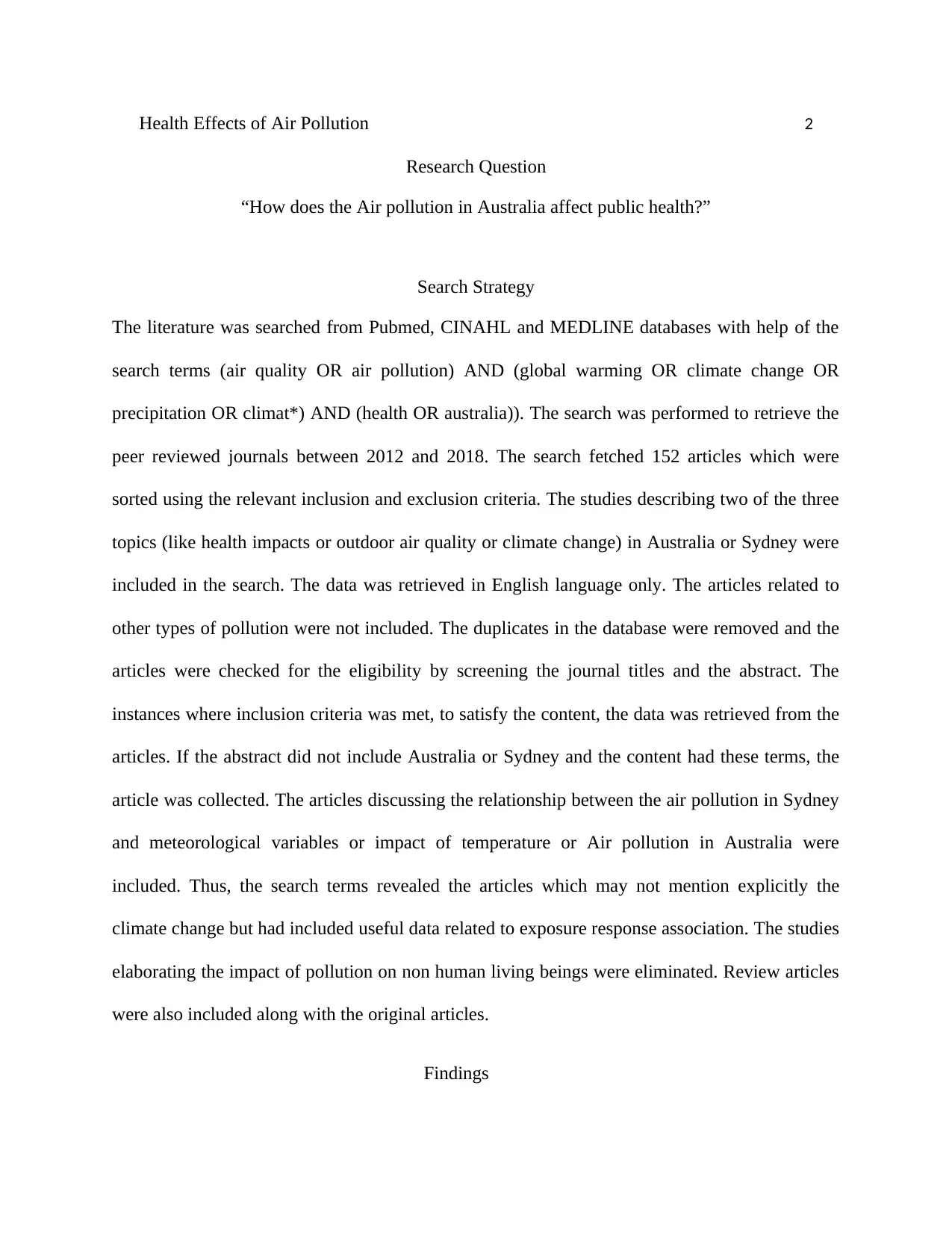
Health Effects of Air Pollution 2
Research Question
“How does the Air pollution in Australia affect public health?”
Search Strategy
The literature was searched from Pubmed, CINAHL and MEDLINE databases with help of the
search terms (air quality OR air pollution) AND (global warming OR climate change OR
precipitation OR climat*) AND (health OR australia)). The search was performed to retrieve the
peer reviewed journals between 2012 and 2018. The search fetched 152 articles which were
sorted using the relevant inclusion and exclusion criteria. The studies describing two of the three
topics (like health impacts or outdoor air quality or climate change) in Australia or Sydney were
included in the search. The data was retrieved in English language only. The articles related to
other types of pollution were not included. The duplicates in the database were removed and the
articles were checked for the eligibility by screening the journal titles and the abstract. The
instances where inclusion criteria was met, to satisfy the content, the data was retrieved from the
articles. If the abstract did not include Australia or Sydney and the content had these terms, the
article was collected. The articles discussing the relationship between the air pollution in Sydney
and meteorological variables or impact of temperature or Air pollution in Australia were
included. Thus, the search terms revealed the articles which may not mention explicitly the
climate change but had included useful data related to exposure response association. The studies
elaborating the impact of pollution on non human living beings were eliminated. Review articles
were also included along with the original articles.
Findings
Research Question
“How does the Air pollution in Australia affect public health?”
Search Strategy
The literature was searched from Pubmed, CINAHL and MEDLINE databases with help of the
search terms (air quality OR air pollution) AND (global warming OR climate change OR
precipitation OR climat*) AND (health OR australia)). The search was performed to retrieve the
peer reviewed journals between 2012 and 2018. The search fetched 152 articles which were
sorted using the relevant inclusion and exclusion criteria. The studies describing two of the three
topics (like health impacts or outdoor air quality or climate change) in Australia or Sydney were
included in the search. The data was retrieved in English language only. The articles related to
other types of pollution were not included. The duplicates in the database were removed and the
articles were checked for the eligibility by screening the journal titles and the abstract. The
instances where inclusion criteria was met, to satisfy the content, the data was retrieved from the
articles. If the abstract did not include Australia or Sydney and the content had these terms, the
article was collected. The articles discussing the relationship between the air pollution in Sydney
and meteorological variables or impact of temperature or Air pollution in Australia were
included. Thus, the search terms revealed the articles which may not mention explicitly the
climate change but had included useful data related to exposure response association. The studies
elaborating the impact of pollution on non human living beings were eliminated. Review articles
were also included along with the original articles.
Findings

Health Effects of Air Pollution 3
The findings were revealed that air pollution affects the cardio-respiratory function of the body
which may range from minor respiratory distress to enhanced mortality and hospital
readmissions (Stacy, 2017). The use of biomass and coal has been associated with extreme levels
of indoor and outdoor air pollution in developed countries. The fuel industry has been burning
coal to produce electricity in several countries like China and India. Moreover, traffic congestion
has also been contributing to air pollution.
The major air pollutants in Australia and worldwide are particulate matter (PM), Carbon
Monoxide, Ozone, Nitrogen Oxide, Air toxics etc. Chemical composition and size of the
pollutants plays a significant role in causing cardiorespiratory effects specially the size smaller
than 1 miu meter and 2.5 miu meter (Armstrong, 2012). They can penetrate deeper into the body
adversely affecting the respiratory system. Exposure to carcinogenic air pollutants (like benzene)
for long term causes cancer. Fuel combustion produces carbon dioxide which is the major green
house gas affecting the climate change. In Australia, vehicle borne CO2 emission contributes to
green house gas emissions. According to American Thoracic Society (ATS) the air pollution
impacts the adverse health effects like loss of respiratory function, hospital readmissions,
mortality and also deteriorates the quality of life. The major adverse health impacts of air
pollution are as follows:
1. Increases mortality
2. Increases the incidence of lung cancer
3. Enhances the incidence of lower respiratory tract infections
4. Decreases pulmonary efficiency
5. Increases the prevalence of chest tightness
The findings were revealed that air pollution affects the cardio-respiratory function of the body
which may range from minor respiratory distress to enhanced mortality and hospital
readmissions (Stacy, 2017). The use of biomass and coal has been associated with extreme levels
of indoor and outdoor air pollution in developed countries. The fuel industry has been burning
coal to produce electricity in several countries like China and India. Moreover, traffic congestion
has also been contributing to air pollution.
The major air pollutants in Australia and worldwide are particulate matter (PM), Carbon
Monoxide, Ozone, Nitrogen Oxide, Air toxics etc. Chemical composition and size of the
pollutants plays a significant role in causing cardiorespiratory effects specially the size smaller
than 1 miu meter and 2.5 miu meter (Armstrong, 2012). They can penetrate deeper into the body
adversely affecting the respiratory system. Exposure to carcinogenic air pollutants (like benzene)
for long term causes cancer. Fuel combustion produces carbon dioxide which is the major green
house gas affecting the climate change. In Australia, vehicle borne CO2 emission contributes to
green house gas emissions. According to American Thoracic Society (ATS) the air pollution
impacts the adverse health effects like loss of respiratory function, hospital readmissions,
mortality and also deteriorates the quality of life. The major adverse health impacts of air
pollution are as follows:
1. Increases mortality
2. Increases the incidence of lung cancer
3. Enhances the incidence of lower respiratory tract infections
4. Decreases pulmonary efficiency
5. Increases the prevalence of chest tightness
⊘ This is a preview!⊘
Do you want full access?
Subscribe today to unlock all pages.

Trusted by 1+ million students worldwide

Health Effects of Air Pollution 4
6. Cause throat, eye and nose irritation
7. Increases the production of cough and phlegm
8. Increases the frequency of asthma attack
Certain studies reported increased mortality rate and its association with air pollution if exposed
for longer time. A study of 6 cities by American Cancer Society found that an average increase
in the pollutant density by 10 miu grams in air reflects 3-4% increase in the rate of mortality
(Office of Environment and Heritage, 2018). This increase in the number of pollutants is
associated with cardio-respiratory illness and cancer. The acute exposure to ozone is also
associated with increased mortality in Australia. The particle pollution has also found to be
associated with increased daily hospital readmissions. Dust storms have found to be significantly
affecting the lung function and asthma. The air pollution in any level influences the increased
mortality rates. Interventions like increased use of public transport, cycling and walking, using
the vehicles producing low pollution, and efficient use of household cooling and heating devices.
According to International Agency for Research in Cancer (2013) found that exposure to
Particulate matter such as Biomass and fossil fuel combustion, cigarette smoking and motor
vehicle engines cause the upper respiratory tract infections and cardiovascular illness. The most
vulnerable sections affected by the particulate matter exposure are elderly people and children.
The contributing factors are sulfuric acid, sulfur dioxide, humidity, heat and cold.
Acid Aerosols and Sulfur Dioxide produced from metal smelting and fossil fuel combustion
cause throat irritation and exacerbation of cardio-respiratory distress. People especially
vulnerable are people with respiratory issues. Ozone causes reduced capacity of exercise, throat
6. Cause throat, eye and nose irritation
7. Increases the production of cough and phlegm
8. Increases the frequency of asthma attack
Certain studies reported increased mortality rate and its association with air pollution if exposed
for longer time. A study of 6 cities by American Cancer Society found that an average increase
in the pollutant density by 10 miu grams in air reflects 3-4% increase in the rate of mortality
(Office of Environment and Heritage, 2018). This increase in the number of pollutants is
associated with cardio-respiratory illness and cancer. The acute exposure to ozone is also
associated with increased mortality in Australia. The particle pollution has also found to be
associated with increased daily hospital readmissions. Dust storms have found to be significantly
affecting the lung function and asthma. The air pollution in any level influences the increased
mortality rates. Interventions like increased use of public transport, cycling and walking, using
the vehicles producing low pollution, and efficient use of household cooling and heating devices.
According to International Agency for Research in Cancer (2013) found that exposure to
Particulate matter such as Biomass and fossil fuel combustion, cigarette smoking and motor
vehicle engines cause the upper respiratory tract infections and cardiovascular illness. The most
vulnerable sections affected by the particulate matter exposure are elderly people and children.
The contributing factors are sulfuric acid, sulfur dioxide, humidity, heat and cold.
Acid Aerosols and Sulfur Dioxide produced from metal smelting and fossil fuel combustion
cause throat irritation and exacerbation of cardio-respiratory distress. People especially
vulnerable are people with respiratory issues. Ozone causes reduced capacity of exercise, throat
Paraphrase This Document
Need a fresh take? Get an instant paraphrase of this document with our AI Paraphraser
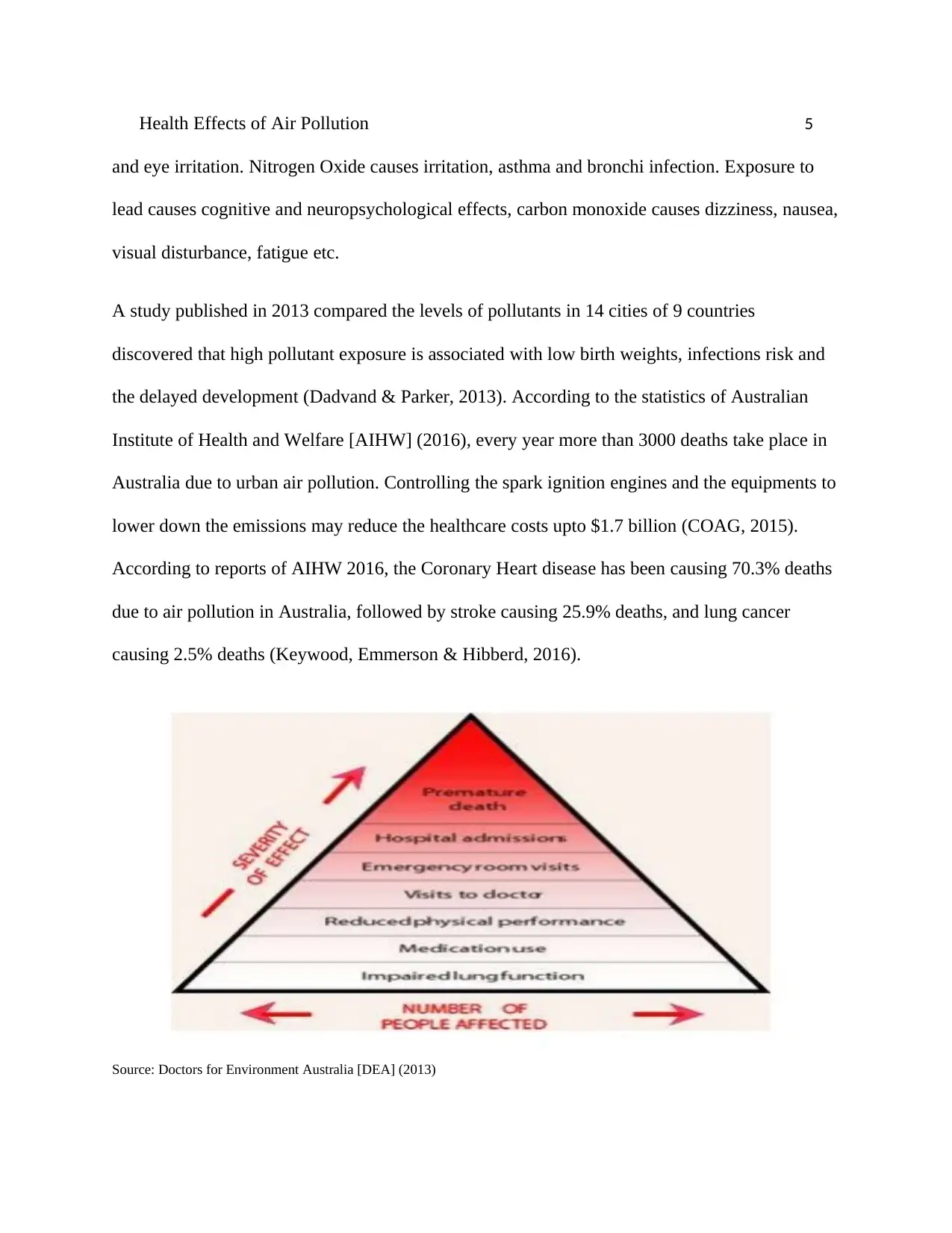
Health Effects of Air Pollution 5
and eye irritation. Nitrogen Oxide causes irritation, asthma and bronchi infection. Exposure to
lead causes cognitive and neuropsychological effects, carbon monoxide causes dizziness, nausea,
visual disturbance, fatigue etc.
A study published in 2013 compared the levels of pollutants in 14 cities of 9 countries
discovered that high pollutant exposure is associated with low birth weights, infections risk and
the delayed development (Dadvand & Parker, 2013). According to the statistics of Australian
Institute of Health and Welfare [AIHW] (2016), every year more than 3000 deaths take place in
Australia due to urban air pollution. Controlling the spark ignition engines and the equipments to
lower down the emissions may reduce the healthcare costs upto $1.7 billion (COAG, 2015).
According to reports of AIHW 2016, the Coronary Heart disease has been causing 70.3% deaths
due to air pollution in Australia, followed by stroke causing 25.9% deaths, and lung cancer
causing 2.5% deaths (Keywood, Emmerson & Hibberd, 2016).
Source: Doctors for Environment Australia [DEA] (2013)
and eye irritation. Nitrogen Oxide causes irritation, asthma and bronchi infection. Exposure to
lead causes cognitive and neuropsychological effects, carbon monoxide causes dizziness, nausea,
visual disturbance, fatigue etc.
A study published in 2013 compared the levels of pollutants in 14 cities of 9 countries
discovered that high pollutant exposure is associated with low birth weights, infections risk and
the delayed development (Dadvand & Parker, 2013). According to the statistics of Australian
Institute of Health and Welfare [AIHW] (2016), every year more than 3000 deaths take place in
Australia due to urban air pollution. Controlling the spark ignition engines and the equipments to
lower down the emissions may reduce the healthcare costs upto $1.7 billion (COAG, 2015).
According to reports of AIHW 2016, the Coronary Heart disease has been causing 70.3% deaths
due to air pollution in Australia, followed by stroke causing 25.9% deaths, and lung cancer
causing 2.5% deaths (Keywood, Emmerson & Hibberd, 2016).
Source: Doctors for Environment Australia [DEA] (2013)
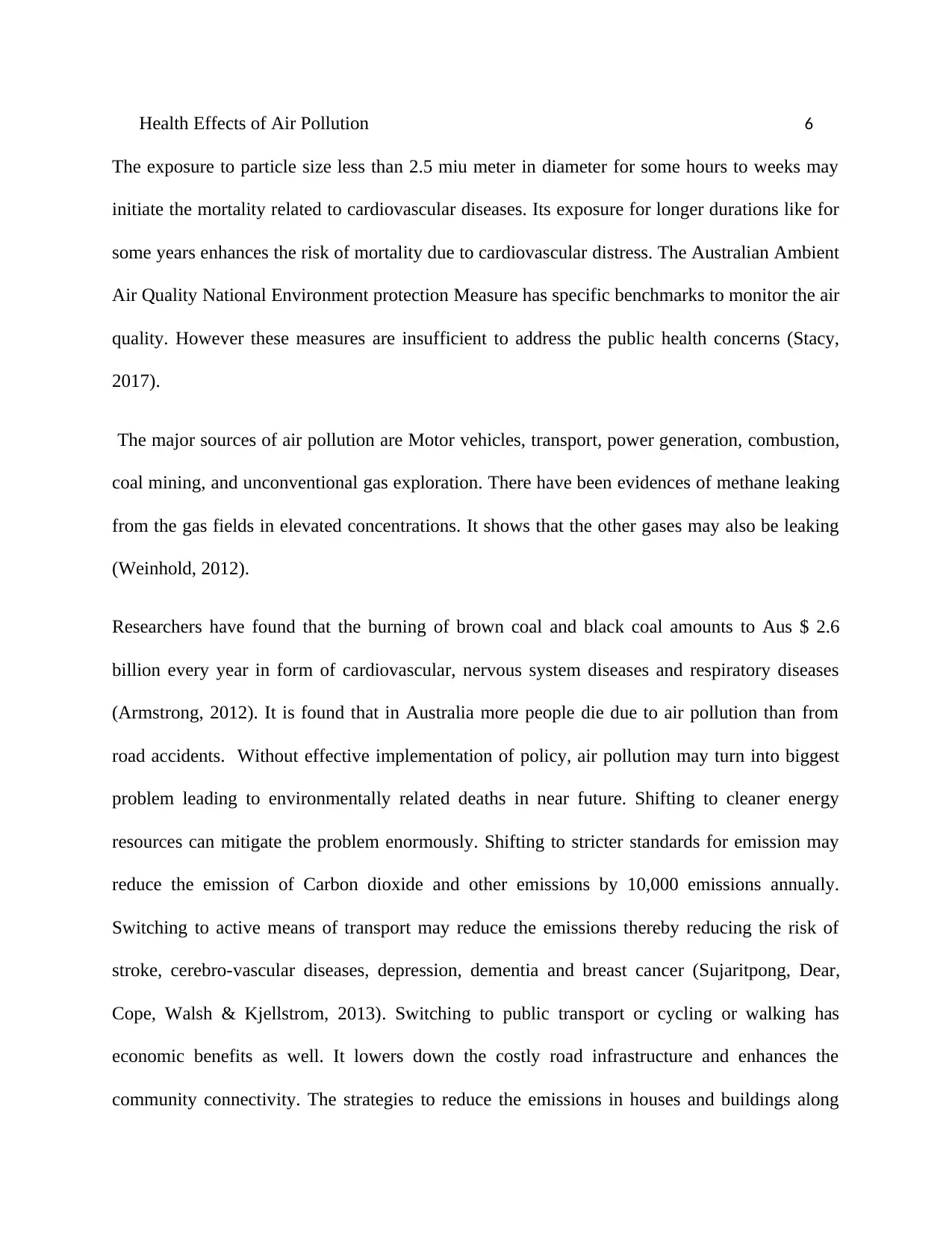
Health Effects of Air Pollution 6
The exposure to particle size less than 2.5 miu meter in diameter for some hours to weeks may
initiate the mortality related to cardiovascular diseases. Its exposure for longer durations like for
some years enhances the risk of mortality due to cardiovascular distress. The Australian Ambient
Air Quality National Environment protection Measure has specific benchmarks to monitor the air
quality. However these measures are insufficient to address the public health concerns (Stacy,
2017).
The major sources of air pollution are Motor vehicles, transport, power generation, combustion,
coal mining, and unconventional gas exploration. There have been evidences of methane leaking
from the gas fields in elevated concentrations. It shows that the other gases may also be leaking
(Weinhold, 2012).
Researchers have found that the burning of brown coal and black coal amounts to Aus $ 2.6
billion every year in form of cardiovascular, nervous system diseases and respiratory diseases
(Armstrong, 2012). It is found that in Australia more people die due to air pollution than from
road accidents. Without effective implementation of policy, air pollution may turn into biggest
problem leading to environmentally related deaths in near future. Shifting to cleaner energy
resources can mitigate the problem enormously. Shifting to stricter standards for emission may
reduce the emission of Carbon dioxide and other emissions by 10,000 emissions annually.
Switching to active means of transport may reduce the emissions thereby reducing the risk of
stroke, cerebro-vascular diseases, depression, dementia and breast cancer (Sujaritpong, Dear,
Cope, Walsh & Kjellstrom, 2013). Switching to public transport or cycling or walking has
economic benefits as well. It lowers down the costly road infrastructure and enhances the
community connectivity. The strategies to reduce the emissions in houses and buildings along
The exposure to particle size less than 2.5 miu meter in diameter for some hours to weeks may
initiate the mortality related to cardiovascular diseases. Its exposure for longer durations like for
some years enhances the risk of mortality due to cardiovascular distress. The Australian Ambient
Air Quality National Environment protection Measure has specific benchmarks to monitor the air
quality. However these measures are insufficient to address the public health concerns (Stacy,
2017).
The major sources of air pollution are Motor vehicles, transport, power generation, combustion,
coal mining, and unconventional gas exploration. There have been evidences of methane leaking
from the gas fields in elevated concentrations. It shows that the other gases may also be leaking
(Weinhold, 2012).
Researchers have found that the burning of brown coal and black coal amounts to Aus $ 2.6
billion every year in form of cardiovascular, nervous system diseases and respiratory diseases
(Armstrong, 2012). It is found that in Australia more people die due to air pollution than from
road accidents. Without effective implementation of policy, air pollution may turn into biggest
problem leading to environmentally related deaths in near future. Shifting to cleaner energy
resources can mitigate the problem enormously. Shifting to stricter standards for emission may
reduce the emission of Carbon dioxide and other emissions by 10,000 emissions annually.
Switching to active means of transport may reduce the emissions thereby reducing the risk of
stroke, cerebro-vascular diseases, depression, dementia and breast cancer (Sujaritpong, Dear,
Cope, Walsh & Kjellstrom, 2013). Switching to public transport or cycling or walking has
economic benefits as well. It lowers down the costly road infrastructure and enhances the
community connectivity. The strategies to reduce the emissions in houses and buildings along
⊘ This is a preview!⊘
Do you want full access?
Subscribe today to unlock all pages.

Trusted by 1+ million students worldwide
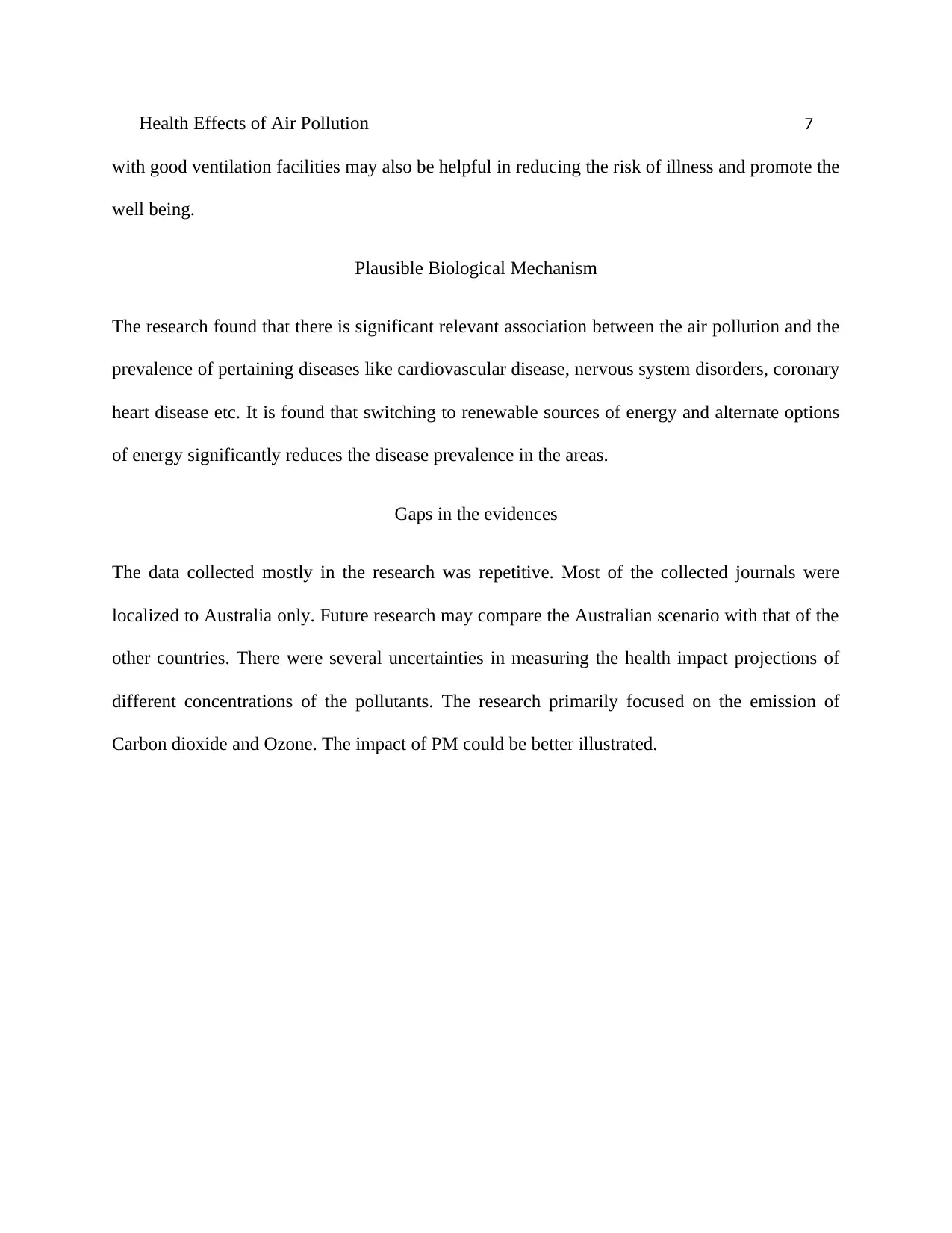
Health Effects of Air Pollution 7
with good ventilation facilities may also be helpful in reducing the risk of illness and promote the
well being.
Plausible Biological Mechanism
The research found that there is significant relevant association between the air pollution and the
prevalence of pertaining diseases like cardiovascular disease, nervous system disorders, coronary
heart disease etc. It is found that switching to renewable sources of energy and alternate options
of energy significantly reduces the disease prevalence in the areas.
Gaps in the evidences
The data collected mostly in the research was repetitive. Most of the collected journals were
localized to Australia only. Future research may compare the Australian scenario with that of the
other countries. There were several uncertainties in measuring the health impact projections of
different concentrations of the pollutants. The research primarily focused on the emission of
Carbon dioxide and Ozone. The impact of PM could be better illustrated.
with good ventilation facilities may also be helpful in reducing the risk of illness and promote the
well being.
Plausible Biological Mechanism
The research found that there is significant relevant association between the air pollution and the
prevalence of pertaining diseases like cardiovascular disease, nervous system disorders, coronary
heart disease etc. It is found that switching to renewable sources of energy and alternate options
of energy significantly reduces the disease prevalence in the areas.
Gaps in the evidences
The data collected mostly in the research was repetitive. Most of the collected journals were
localized to Australia only. Future research may compare the Australian scenario with that of the
other countries. There were several uncertainties in measuring the health impact projections of
different concentrations of the pollutants. The research primarily focused on the emission of
Carbon dioxide and Ozone. The impact of PM could be better illustrated.
Paraphrase This Document
Need a fresh take? Get an instant paraphrase of this document with our AI Paraphraser
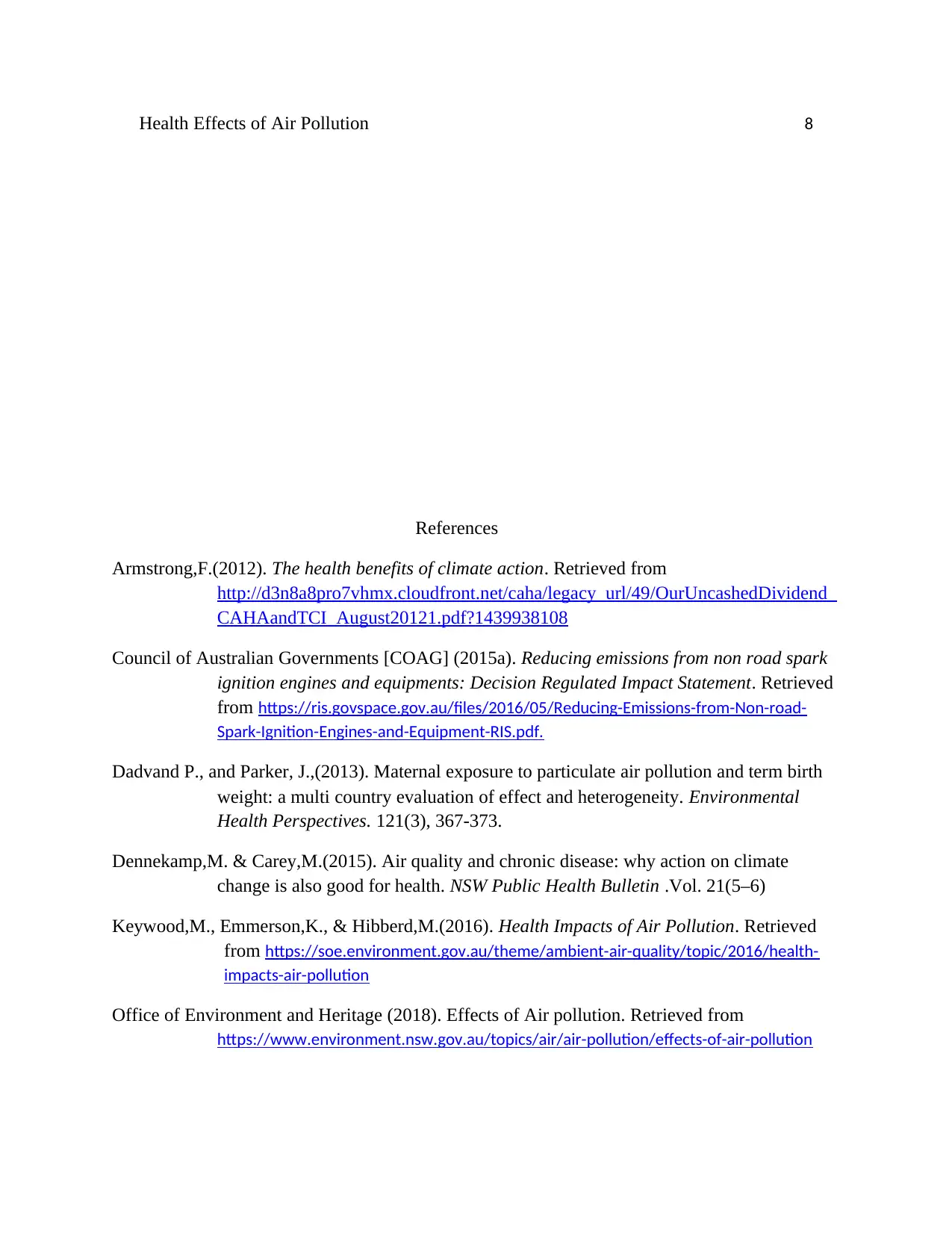
Health Effects of Air Pollution 8
References
Armstrong,F.(2012). The health benefits of climate action. Retrieved from
http://d3n8a8pro7vhmx.cloudfront.net/caha/legacy_url/49/OurUncashedDividend_
CAHAandTCI_August20121.pdf?1439938108
Council of Australian Governments [COAG] (2015a). Reducing emissions from non road spark
ignition engines and equipments: Decision Regulated Impact Statement. Retrieved
from https://ris.govspace.gov.au/files/2016/05/Reducing-Emissions-from-Non-road-
Spark-Ignition-Engines-and-Equipment-RIS.pdf.
Dadvand P., and Parker, J.,(2013). Maternal exposure to particulate air pollution and term birth
weight: a multi country evaluation of effect and heterogeneity. Environmental
Health Perspectives. 121(3), 367-373.
Dennekamp,M. & Carey,M.(2015). Air quality and chronic disease: why action on climate
change is also good for health. NSW Public Health Bulletin .Vol. 21(5–6)
Keywood,M., Emmerson,K., & Hibberd,M.(2016). Health Impacts of Air Pollution. Retrieved
from https://soe.environment.gov.au/theme/ambient-air-quality/topic/2016/health-
impacts-air-pollution
Office of Environment and Heritage (2018). Effects of Air pollution. Retrieved from
https://www.environment.nsw.gov.au/topics/air/air-pollution/effects-of-air-pollution
References
Armstrong,F.(2012). The health benefits of climate action. Retrieved from
http://d3n8a8pro7vhmx.cloudfront.net/caha/legacy_url/49/OurUncashedDividend_
CAHAandTCI_August20121.pdf?1439938108
Council of Australian Governments [COAG] (2015a). Reducing emissions from non road spark
ignition engines and equipments: Decision Regulated Impact Statement. Retrieved
from https://ris.govspace.gov.au/files/2016/05/Reducing-Emissions-from-Non-road-
Spark-Ignition-Engines-and-Equipment-RIS.pdf.
Dadvand P., and Parker, J.,(2013). Maternal exposure to particulate air pollution and term birth
weight: a multi country evaluation of effect and heterogeneity. Environmental
Health Perspectives. 121(3), 367-373.
Dennekamp,M. & Carey,M.(2015). Air quality and chronic disease: why action on climate
change is also good for health. NSW Public Health Bulletin .Vol. 21(5–6)
Keywood,M., Emmerson,K., & Hibberd,M.(2016). Health Impacts of Air Pollution. Retrieved
from https://soe.environment.gov.au/theme/ambient-air-quality/topic/2016/health-
impacts-air-pollution
Office of Environment and Heritage (2018). Effects of Air pollution. Retrieved from
https://www.environment.nsw.gov.au/topics/air/air-pollution/effects-of-air-pollution
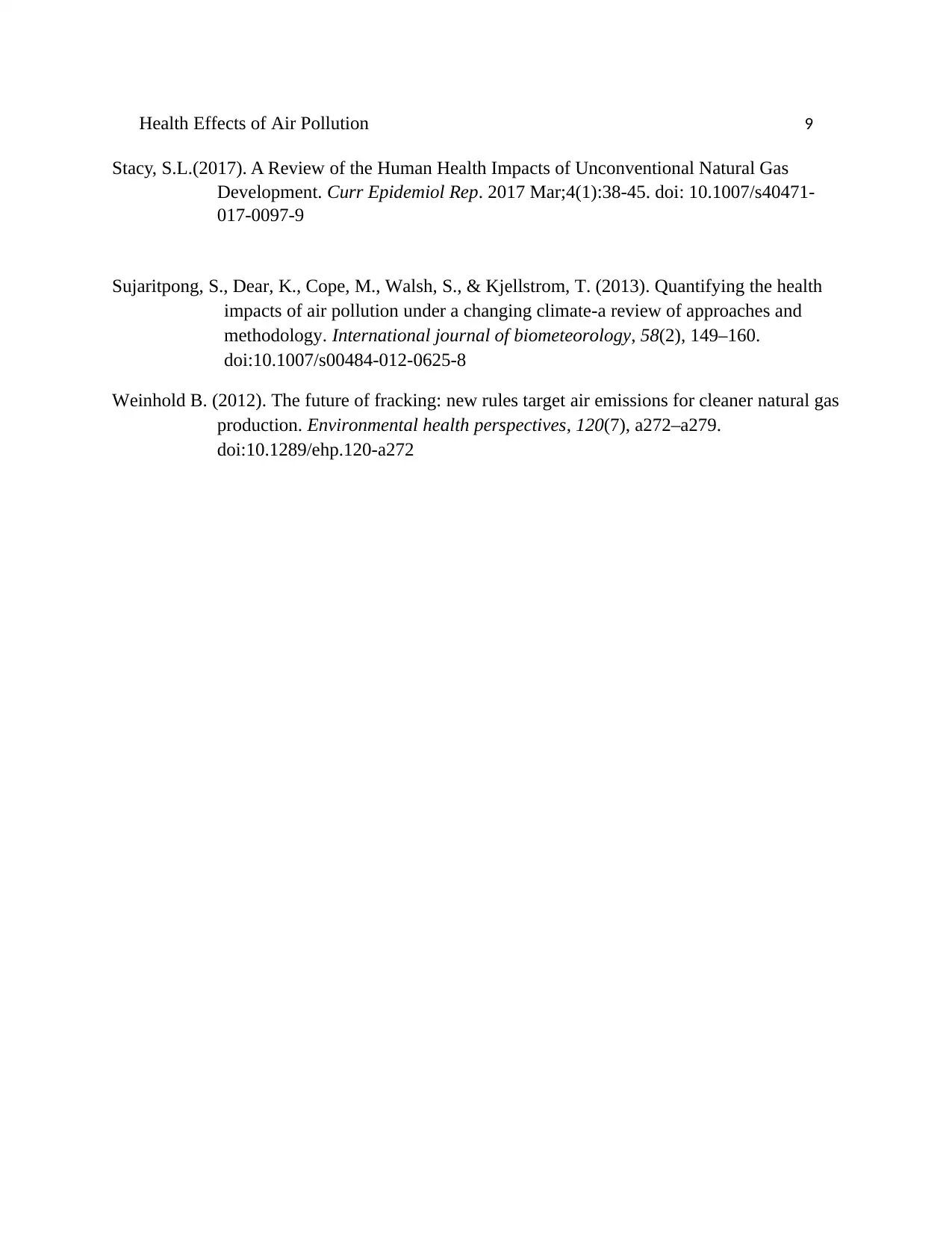
Health Effects of Air Pollution 9
Stacy, S.L.(2017). A Review of the Human Health Impacts of Unconventional Natural Gas
Development. Curr Epidemiol Rep. 2017 Mar;4(1):38-45. doi: 10.1007/s40471-
017-0097-9
Sujaritpong, S., Dear, K., Cope, M., Walsh, S., & Kjellstrom, T. (2013). Quantifying the health
impacts of air pollution under a changing climate-a review of approaches and
methodology. International journal of biometeorology, 58(2), 149–160.
doi:10.1007/s00484-012-0625-8
Weinhold B. (2012). The future of fracking: new rules target air emissions for cleaner natural gas
production. Environmental health perspectives, 120(7), a272–a279.
doi:10.1289/ehp.120-a272
Stacy, S.L.(2017). A Review of the Human Health Impacts of Unconventional Natural Gas
Development. Curr Epidemiol Rep. 2017 Mar;4(1):38-45. doi: 10.1007/s40471-
017-0097-9
Sujaritpong, S., Dear, K., Cope, M., Walsh, S., & Kjellstrom, T. (2013). Quantifying the health
impacts of air pollution under a changing climate-a review of approaches and
methodology. International journal of biometeorology, 58(2), 149–160.
doi:10.1007/s00484-012-0625-8
Weinhold B. (2012). The future of fracking: new rules target air emissions for cleaner natural gas
production. Environmental health perspectives, 120(7), a272–a279.
doi:10.1289/ehp.120-a272
⊘ This is a preview!⊘
Do you want full access?
Subscribe today to unlock all pages.

Trusted by 1+ million students worldwide
1 out of 9
Related Documents
Your All-in-One AI-Powered Toolkit for Academic Success.
+13062052269
info@desklib.com
Available 24*7 on WhatsApp / Email
![[object Object]](/_next/static/media/star-bottom.7253800d.svg)
Unlock your academic potential
Copyright © 2020–2025 A2Z Services. All Rights Reserved. Developed and managed by ZUCOL.





